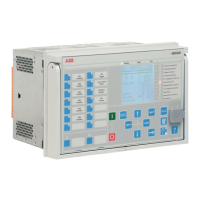changed. The network rotating direction is defined with a system parameter
Phase
rotation
. The calculation of the component is affected but the angle difference
calculation remains the same. When the residual voltage is used as the polarizing
method, the network rotating direction change has no effect on the direction
calculation.
The network rotating direction is set in the protection relay using the
parameter in the HMI menu: Configuration > System > Phase rotation.
The default parameter value is "ABC".
If the
Enable voltage limit
setting is set to "True", the magnitude of
the polarizing quantity is checked even if
Directional mode
is set to
"Non-directional" or
Allow Non Dir
to "True".
The
Characteristic angle
setting is used in the "Phase angle" mode to adjust the
operation according to the method of neutral point earthing so that in an isolated
network the
Characteristic angle
(φ
RCA
) = -90° and in a compensated network φ
RCA
= 0°. In addition, the characteristic angle can be changed via the control signal
RCA_CTL. RCA_CTL affects the
Characteristic angle
setting.
The
Correction angle
setting can be used to improve selectivity due the inaccuracies
in the measurement transformers. The setting decreases the operation sector. The
correction can only be used with the "IoCos" or "IoSin" modes.
The polarity of the polarizing quantity can be reversed by setting the
Pol reversal
to
"True", which turns the polarizing quantity by 180 degrees.
For definitions of different directional earth-fault characteristics, see
Chapter 4.2.2.8 Directional earth-fault characteristics
in this manual.
For definitions of different directional earth-fault characteristics, refer to
general function block features information.
The directional calculation module calculates several values which are presented in
the monitored data.
Table 402: Monitored data values
Monitored data values Description
FAULT_DIR The detected direction of fault during fault
situations, that is, when START output is ac-
tive.
DIRECTION The momentary operating direction indica-
tion output.
ANGLE Also called operating angle, shows the angle
difference between the polarizing quantity
(Uo, U2) and operating quantity (Io, I2).
Table continues on the next page
1MRS757644 H Protection functions
620 series
Technical Manual
391

